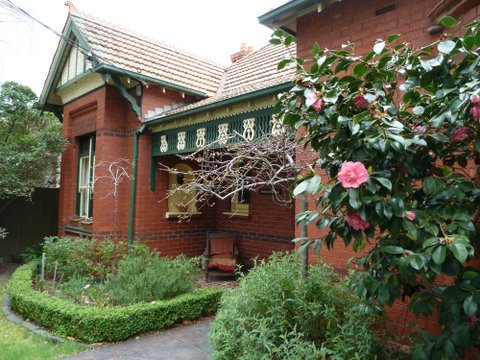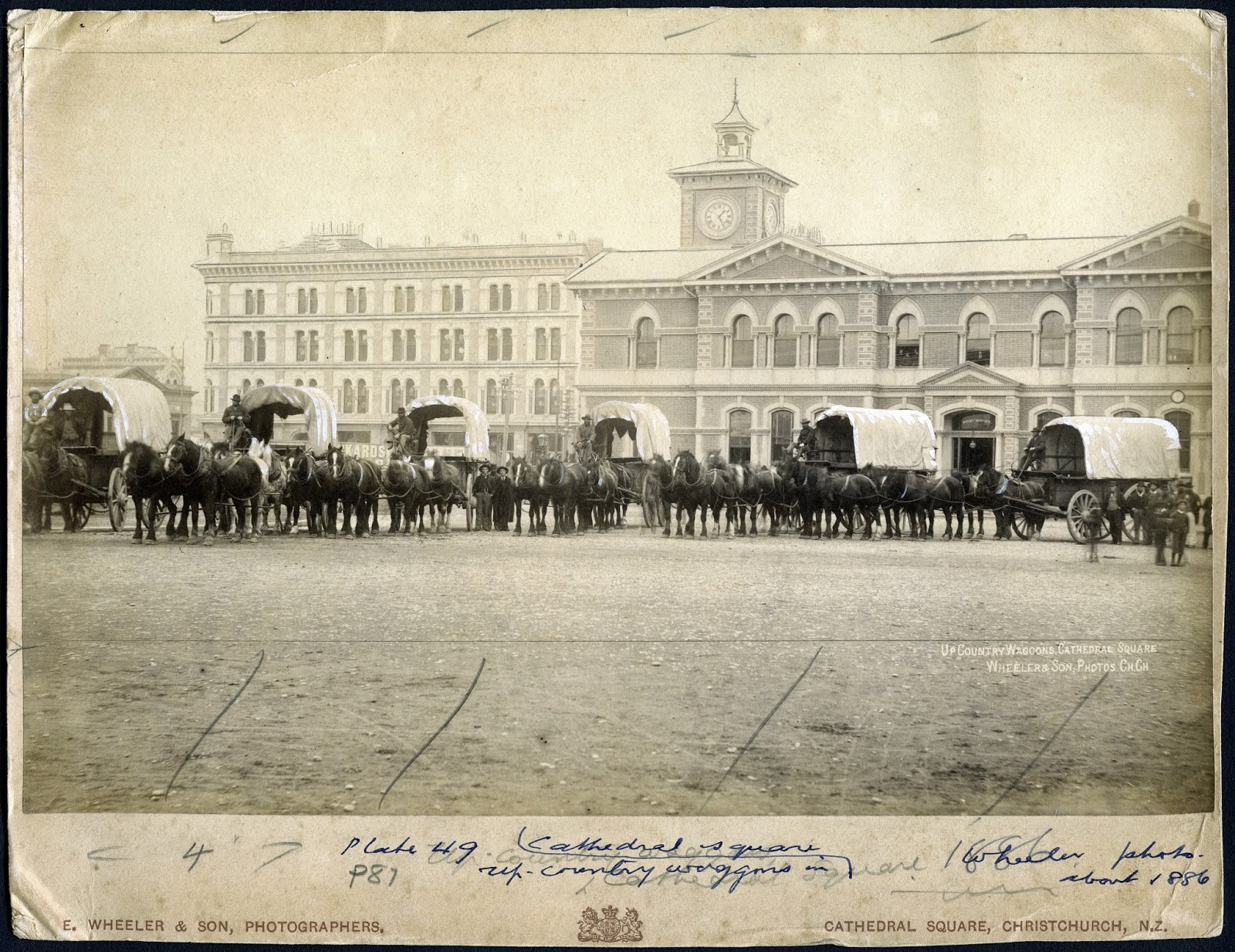This week's prompt shows a number of men wearing name tags, busily serving themselves from a generous spread of food. It was a 50th anniversary dinner, which made me think immediately of the following photograph taken on the occasion of my great great grandparents Adam and Charlotte Cruickshank's golden anniversary on 19 January 1906. They celebrated the momentous achievement with a large gathering of family and friends at their property known as Oakdale, near the town of Gore on the South Island of New Zealand. You can see a painting of Oakdale by Adam and Charlotte's granddaughter Charlotte Petrie here.
Unfortunately for me, no one at the celebration was wearing name tags. No doubt they all knew each other.
I don't have any photographs of the tables that must have been groaning with food, but I do have copies of an invitation to the celebration, and of the banquet menu, which included roast goose, roast duck, roast fowl and roast beef, pickled ham and ox tongue, together with potatoes and vegetable salads. The desserts included cream kisses. The guests at their golden wedding celebration were treated to a sumptuous banquet laid out in the barn and 'catered for by Mr McFarlane in his characteristic complete style'.
| Invitees Mr and Mrs Gavin Dickson were the parents of Helen Warner Dickson, wife of Adam and Charlotte's son James Alfred Cruickshank. James and Helen had been married 3 years earlier. |
| Thiis scan of the menu is cropped slightly, but is still legible. |
According to a detailed report that appeared in the Mataura Ensign the following day, the guests numbered over 100 and included shipmates of the Cruickshanks from when they arrived in Invercargill NZ in 1863, aboard the New Great Britain. They had been married in Monquhitter Aberdeenshire on 19 January 1856 by the Rev. James Adam, with Mrs Cruickshank, whose maiden name was Charlotte Joss, having to ride 35 miles by stagecoach to be present on the morning of the ceremony.
Naturally the numerous speeches were highly complimentary to the host couple. The chairman said he thought it was 'a peculiarly auspicious occasion, and all their friends would rejoice to see, after fifty years of happily wedded life, Mr and Mrs Cruickshank looking so well and hearty. One could scarcely realise that they were more than fifty years of age.' He trusted they would all be spared to return in ten years' time for the celebration of their hosts' diamond wedding day. One reason he thought 'they looked so well and were so strong was that they had employed their youthful days wisely. A wasteful youth led to premature old age, but there was no evidence of weakness in either Mr or Mrs Cruickshank.' He trusted they would long preserve that activity. All wished them every happiness and days to come full of blessings from the Lord, and that 'in the end God would bless them with His grace and would finally take them into His peace for ever more'.
Another speaker remarked that while he had 'heard it said that "Happy the bride that the sun shines on", happier still was the bride upon whom fifty summers had shone and who had brought up such a family as Mrs Cruickshank had'. Yet another said that in his bachelor days he invariably made for Mrs Cruickshank's hospitable homestead on a Sunday, being sure of a good meal The couple had raised one daughter, seven 'stalwart' sons, and 'a great array' of 30 grandchildren. After the speeches, the guests adjourned to the garden where photographs were taken, and then guests repaired again to the banqueting hall.
During the afternoon songs were given by several guests, and 'at a later hour young people to the number of over one hundred were entertained at the Cruickshank residence to join in further celebration of the notable event, The evening was devoted to dancing and singing ... Miss Dickson danced a highland fling and Mr H. Milne a hornpipe.' Excellent music was provided by various guests on the piano, violin and bagpipes, and proceedings lasted until daylight. The Cruickshanks may have been dour Presbyterians, but they certainly knew how to celebrate!
Despite all those fervent good wishes for continued good health, Charlotte passed away two years later in 1908 and Adam followed on 11 October 1914, just over 100 hundred years ago now. He actually married again in 1911, but when he died he was residing at the home of his daughter Jessie Petrie and it is not known whether or not his second wife Janet was living there with him. Just a few days after Adam's death, his grandson Oliver embarked from Wellington with the NZ Machine Gun Corps, bound for Egypt.
The next photograph is of the 25th wedding anniversary celebration of Doris and Frank Olds in Hull, England in 1949. Doris in particular has featured in previous blogs, for example here on her 100th birthday, and also here. Frank and Doris's eldest daughter Mary left England for Australia as a war bride in late 1946, but she made and posted that cake back to England as an anniversary present for her parents, who are seated at the far end of the table. Ingredients would have been easier to come by in post-war Australia than in England with the rationing system still in force.
 |
| Another golden wedding anniversary - Mona and Jack Morrison, parents of Jean Cruickshank nee Morrison, celebrated sedately in Christchurch NZ on 2 April 1969 |
Here are a couple of informal photos of another anniversary celebration from more recent times, namely my in-laws' fortieth wedding anniversary, which they celebrated near Canberra in January 1987. The trolley table on which the cake stands was a gift from their children and has seen good service in back garden gatherings at the family home ever since. It's very likely that Mary made that cake too, and perhaps Doris gave her a hand.
Neither my father-in-law Bob Featherston nor my own father Ian Cruickshank made it to their respective fiftieth wedding anniversaries. Bob died in 1992, and Ian in February 2000. Like her parents pictured 2 photos previously, Jean had been greatly looking forward to celebrating that landmark on 22 April 2000 but sadly it was not to be.
And finally, a small but colourful 'smorgasbord' selection of party tables from the eighties and nineties, at events that included a first, a fourth and a seventieth birthday, plus a couple of children's Christmas functions. Not a lot of healthy food to be seen here!
If this whets your appetite and you want to see what other Sepians have laid out for us this week, just click here, and don't forget your name tag.







.jpg)








.jpg)



.jpg)





